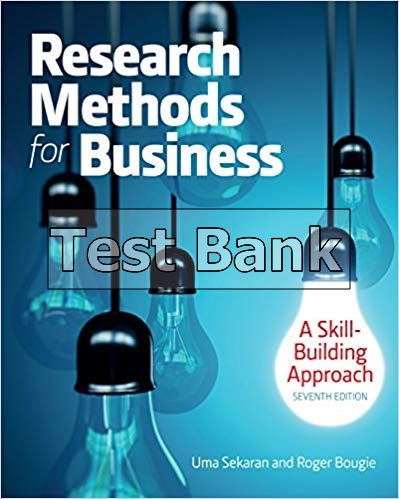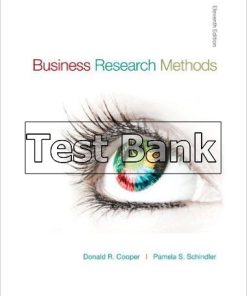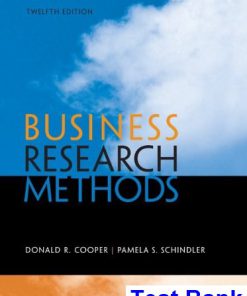Research Methods For Business A Skill Building Approach 7th Edition Sekaran Test Bank
$26.50$50.00 (-47%)
Research Methods For Business A Skill Building Approach 7th Edition Sekaran Test Bank.
You may also like
Research Methods For Business A Skill Building Approach 7th Edition Sekaran Test Bank

Product details:
- ISBN-10 : 1119165555
- ISBN-13 : 978-1119165552
- Author: Uma Sekaran
Common challenges faced by lecturers teaching this course include helping students learn to apply the theory to practice as they proceed with research; and student engagement in what can be a very dry course. Challenges faced by students include understanding research methodology, and quantitative research methods in particular.
The new 7th edition of this title considers these challenges and has evolved to offer a blended learning approach. The goal of this blended approach is to synthesize different teaching and learning approaches into an integrated mix that lecturers can tailor to their own specific needs. An innovative approach combines the face-to-face classroom methods of the instructor with computer-based activities, assignments, and assessments enable students to study what they want, when they want, at their own pace, anywhere they have access to the internet. Students will be led through the entire process of research and thus provide them with the knowledge and skills they need to successfully embark on a research project.
Table contents:
1 Introduction to research 1
Introduction 1
Types of business research: applied and basic 5
Managers and research 8
Internal versus external consultants/researchers 10
Knowledge about research and managerial effectiveness 12
Ethics and business research 13
Summary 13
Discussion questions 14
Case: The Laroche Candy Company 15
2 the scientific approach and alternative approaches to investigation 18
Introduction 18
The hallmarks of scientific research 19
The hypothetico-deductive method 23
Alternative approaches to research 28
Summary 30
Discussion questions 31
3 Defining and refining the problem 33
Introduction 33
The broad problem area 33
Preliminary research 37
Defining the problem statement 39
The research proposal 45
Managerial implications 47
Ethical issues in the preliminary stages of investigation 47
Summary 48
Discussion questions 49
4 the critical literature review 51
Introduction 51
How to approach the literature review 54
Ethical issues 59
Summary 60
Discussion questions 61
Practice project 62
Appendix 63
Some online resources useful for business research 63
Bibliographical databases 66
Apa format for referencing relevant articles 66
Referencing and quotation in the literature review section 69
5 theoretical framework and hypothesis development 71
Introduction 71
The need for a theoretical framework 72
Variables 72
How theory is generated 81
Hypothesis development 83
Directional and nondirectional hypotheses 84
Null and alternate hypotheses 85
Managerial implications 90
Summary 91
Discussion questions 92
Practice project 94
6 elements of research design 95
Introduction 95
The research design 95
Elements of research design 96
Extent of researcher interference with the study 99
Study setting: contrived and noncontrived 100
Unit of analysis: individuals, dyads, groups, organizations, cultures 102
Time horizon: cross-sectional versus longitudinal studies 104
Mixed methods 106
Trade-offs and compromises 107
Managerial implications 108
Summary 108
Discussion questions 109
7 Interviews 111
Introduction 111
Primary data collection methods 111
Interviews 113
Training interviewers 116
Some tips to follow when interviewing 117
Advantages and disadvantages of interviews 123
Summary 123
Discussion questions 124
8 Data collection methods: observation 126
Introduction 126
Definition and purpose of observation 127
Four key dimensions that characterize the type of observation 127
Two important approaches to observation 130
Advantages and disadvantages of observation 137
Summary 139
Discussion questions 140
9 Administering questionnaires 142
Introduction 142
Types of questionnaires 142
Guidelines for questionnaire design 145
International dimensions of surveys 155
Review of the advantages and disadvantages of different Data collection methods and when to use each 157
Multimethods of data collection 158
Managerial implications 159
Ethics in data collection 159
Summary 160
Discussion questions 161
10 experimental designs 165
Introduction 165
The lab experiment 167
The field experiment 172
External and internal validity in experiments 172
Types of experimental design and validity 179
Simulation 184
Ethical issues in experimental design research 185
Managerial implications 186
Summary 187
Discussion questions 189
Appendix: Further experimental designs 190
11 Measurement of variables: operational definition 193
Introduction 193
How variables are measured 193
Operational definition (operationalization) 195
International dimensions of operationalization 204
Summary 204
Discussion questions 205
12 Measurement: scaling, reliability and validity 206
Introduction 206
Four types of scales 207
Rating scales 213
Ranking scales 218
International dimensions of scaling 219
Goodness of measures 220
Reflective versus formative measurement scales 225
Summary 226
Discussion questions 227
Appendix: Examples of some measures 229
13 sampling 235
Introduction 235
Sample data and population values 237
The sampling process 239
Probability sampling 242
Nonprobability sampling 247
Intermezzo: examples of when certain sampling designs would be appropriate 252
Issues of precision and confidence in determining sample size 257
Sample data and hypothesis testing 260
The sample size 261
Sampling as related to qualitative studies 265
Managerial implications 266
Summary 266
Discussion questions 268
14 Quantitative data analysis 271
Introduction 271
Getting the data ready for analysis 273
Getting a feel for the data 278
Excelsior enterprises: descriptive statistics part 1 287
Testing the goodness of measures 289
Excelsior enterprises: descriptive statistics part 2 293
Summary 296
Discussion questions 297
15 Quantitative data analysis: Hypothesis testing 300
Introduction 300
Type i errors, type ii errors, and statistical power 301
Choosing the appropriate statistical technique 302
Excelsior enterprises: hypothesis testing 323
Data warehousing, data mining, and operations research 326
Some software packages useful for data analysis 327
Summary 328
Discussion questions 329
16 Qualitative data analysis 332
Introduction 332
Three important steps in qualitative data analysis 332
Reliability and validity in qualitative research 348
Some other methods of gathering and analyzing qualitative data 350
Big data 351
Summary 351
Discussion questions 352
17 The research report 353
Introduction 353
The written report 354
Contents of the research report 357
Oral presentation 363
Summary 366
Discussion questions 367
Appendix: Examples 368
Report 1: sample of a report involving a descriptive study 368
Report 2: sample of a report offering alternative solutions and explaining the pros and cons of each alternative 371
Report 3: example of an abridged basic research report 373
A Final Note to Students 377
Statistical Tables 379
Glossary 389
Bibliography 399
Index 407












